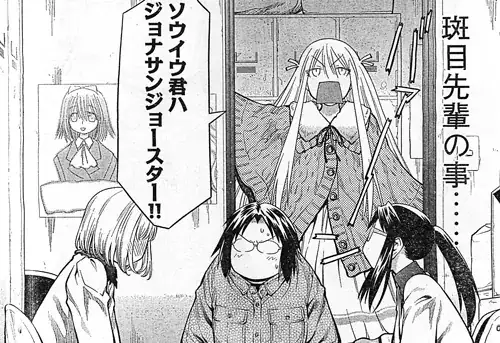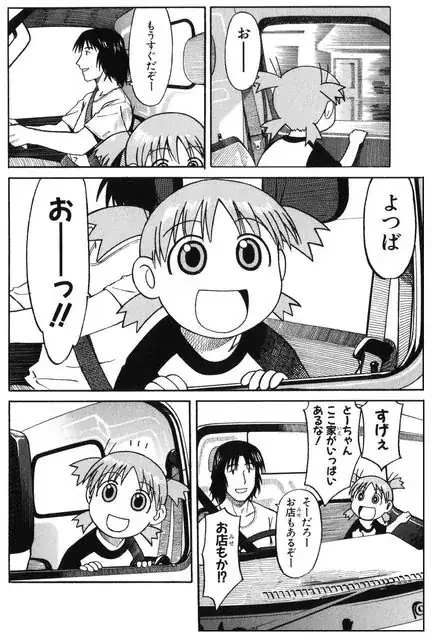I don't read japanese, but I can distinguish katakana/hiragana./kanji
I've noticed that some mangas use a mixture of both. Does the usage of katakana in a primarily hiragana/kanji manga mean anything?
I don't read japanese, but I can distinguish katakana/hiragana./kanji
I've noticed that some mangas use a mixture of both. Does the usage of katakana in a primarily hiragana/kanji manga mean anything?
These two answer covers the topic very well:
- To describe (what feels like) Western origin words
- To describe onomatopoeia (e.g. sounds effects)
- To describe the fact that it is normally written in kanji, but that it is written without it because either the writer wants to write faster, has no access to the kanji form (as in the case where the writer is given the name in a romanized transcription or the writer just heard the name), forgot the kanji form, or does not want to bother to write in kanji for any other reason.
- To give visual and/or very slight semantic emphasis. Almost like using bold or italics in English.
Most commonly katakana seen to be used for the #4. Much like how we can write in lowercase and UPPERCASE to give emphasis. Because it's sometimes difficult to feel the atmosphere when reading such emphasis is generally used in the words.
What most people don't immediate pick up is that much like reason #1, you can use katakana to emphasize foreign-sounding of a particular character speech. It's hard to transcribe a foreign accent (including some but not all verbal tics) in Japanese, but using katakana can get this idea across to the user. It's like if I were to talk to you normally, I would perhaps use a combination of hiragana and kanji, but if I were to talk to you and sound foreign, perhaps LIKE A ROBOT, I would used katakana. This so-called "technique" is used commonly in visual and written novels in Japan, not just for foreign sounding words, but also to emphasize the foreign-ness of a particular person's dialogue.

Hiragana can also be used in a similar fashion. Hiragana is typically the first reading/writing language a kid learns as they start reading in Japan. This is sometimes used to indicated the simpleness or naivety of a character, in general or at a specific moment. In the Yotsuba& manga, the titular character Yotsuba's dialogue is written in hiragana without any kanji, emphasizing her simpler, childlike manner. She also has a slightly different sized and styled typeface to emphasize her intensity and energy as a kid. In addition much of these quirks like her pun-filled nuances are lost in subsequent localizations

Those are the most basic nuances to look for when reading manga. If you're interested in learning more about the language and manga I recommend checking out the book Japanese the Manga Way: An Illustrated Guide to Grammar and Structure by Wayne P. Lammers.
So firstly lets talk about difference between hiragana and katakana.
I found this on a question on a site.
Katakana is mainly used for a loanword, species of animal or plant, the sound generated in the nature or by a machine and so on.
-Loanword: コーヒー(coffee)、サラダ(salad)、パン(bread - derivative from Portuguese "paõ") -Species: イヌ(dog)、ネコ(cat)、コウテイペンギン(emperor penguin or "aptenodytes forsteri") -Sounds: ワンワン(bowwow)、ブーン(zoom)、チョキチョキ(snip-snap)
For other cases the mixture of kanji and hiragana is generally used. Using hiragana without kanji is all right, however, the mixed text is easier to understand if you gradually learn kanji.
-私は車で買い物に行きました。 -わたしはくるまでかいものにいきました。 (I went shopping by car.)
In some cases a car is written 「クルマ」 in katakana. In this case a writer may have a kind of love to the object as much as they have to a pet animal. It is an extraordinary expression.
-私の家族(かぞく)はパパ、 ママ、 おねえさん、 イヌのトム、 このクルマ、 そして、 私です。 (My family members are Dad, Mom, Sister, Tom-a dog, this car, and me.)
Hiragana is used for all kinds of japanese words.
This also gives a nice explanation on the difference between them.
You can also refer to the Japanese writing system
The main reason of why they use katakana could be that the names/words they use in the manga are non-Japanese.
Then it could be a personal decision of the mangaka himself/herself!!
Katakana is used typically for non Japanese words. Common examples include non Japanese names as well as words taken from other languages and pronounced with the Japanese syllables.
Regular Japanese names like Matsumoto will be spelled with Kanji, but when you have a foreign name like Emily, that is spelled with Katakana.
The exception to this is that Japanese first or forenames in manga may be spelled with Katakana. This doesn't happen in real life though. Various celebrities may have their names published in Katakana through out different forms of media, such as magazines, websites, etc. However, their real (non Western) name written in their birth certificate will not contain Katakana.
Sometimes, words can have both an English and Japanese version. For example, the world apple in Japanese is Ringo spelled in Hiragana. However, it is also common for Japanese people to say Apporu (sounds like the actual English word) and this is would be written in Katakana.